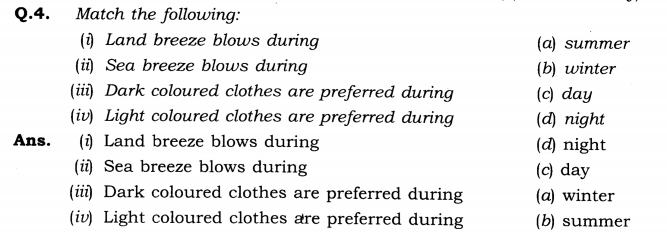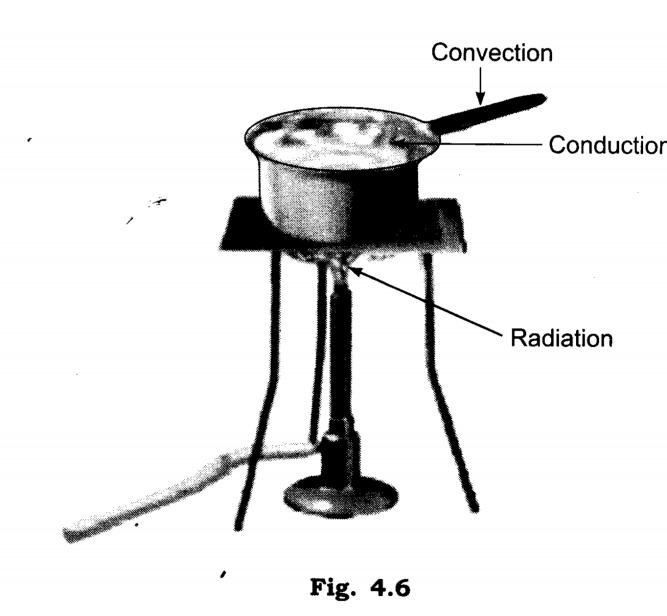Science Class:-7, Chapter:- 4 Heat Notes, NCERT Solutions & Frequently Asked Questions
Science
Class:-7, Chapter:- 4
Heat
Notes, NCERT Solutions & Frequently Asked Questions
-- Notes --
Woollen clothes are obtained from animal fibres. Woollen clothes are generally dark in colour and are worn in the winter season as they protect us from the cold environment.
Cotton clothes are obtained from the plant fibres. The cotton clothes are generally light in colour and are worn in summer season so that we can feel cool.
Hot and Cold
We can understand if an object is hot or cold by the sense of touch. However, it can trick us sometimes. Therefore, we use a thermometer.
The temperature of an object: It is the degree of hotness or coldness of an object.
Thermometer: It is a device that can be used to find out how hot an object is. In other words, we use a thermometer to measure the temperature of an object.
Measuring the temperature of an object using a thermometer
Clinical thermometer

Figure 1 Clinical thermometer
It is a device that is used to measure the body temperature of a person.
It is made up of a glass tube of uniform thickness.
The glass tube contains a bulb at one end which is filled with Mercury.
The Mercury level in the thermometer rises up in the thread-like portion of the thermometer which therefore indicates the temperature of the body.
The level of the Mercury can be measured by reading the scale given on the thermometer.
The scale of the thermometer records the temperature in degree Celsius, generally, 35o C to 45o C, which is the range of human body temperature.
On an average, the temperature of the human body is around 37o C.
The clinical thermometer has a small sharp curve (kink) present near the bulb. This prevents the Mercury level from falling down on its own in the thermometer.
How to use the clinical thermometer?
Firstly, wash the thermometer with an antiseptic solution.
Before taking the temperature the thermometer is given a few jerks to bring down the level of Mercury below 35o C.
Then the thermometer is placed beneath the tongue for about a minute.
Then you can take it out and observe the temperature reading on the thermometer.
What precautions should be taken while using a clinical thermometer?
Wash the thermometer before and after using it.
Make sure the temperature of the thermometer is below 35o C before taking the temperature.
Keep the thermometer straight in order to see the Mercury level precisely.
It should always be held with care or it can break down. You should not touch the bulb of the thermometer at all.
Laboratory thermometer

Figure 2 Laboratory thermometer
The laboratory thermometer is used to find out the temperature of the other objects such as water rather than human body temperature. It can measure the temperature from -10o C to 110o C.
What precautions should be taken when using a laboratory thermometer?

Figure 3 Using Laboratory thermometer
You should always follow the same precautions as that of the clinical thermometer.
You should always hold the laboratory thermometer in a straight upright position without titling it.
The bulb of the thermometer should never touch the surface of the container in which the substance is kept.
However, the bulb of the thermometer should be completely immersed in the substance so that it covers the bulb from all the sides.
Other types of thermometers
Minimum-maximum thermometer: It is a thermometer used to measure the minimum and maximum temperature of the day by weather forecasters.

Figure 4 Minimum-maximum thermometer
Digital thermometer: It is sometimes difficult to handle a Mercury filled thermometer especially when it breaks and the mercury falls out. However, nowadays digital thermometers are available to use. This type of thermometer does not contain Mercury. It directly displays the correct temperature on a display screen.

Figure 5 Digital thermometer
The transfer of heat
The flow of heat always takes place from and hot object to a cold object.
Conduction: The process of flow of heat from a hot object to a cold object is called Conduction. Some objects can conduct heat while others cannot.

Figure 6 Conduction
Conductors: The objects that can allow the heat to flow through them are called Conductors. For Example, metals such as copper and aluminum.

Figure 7 Conductors
Insulators: The objects that do not allow the flow of heat from them are called Insulators. For Example, Wood and Plastic.

Figure 8 Insulators
Convection: The transfer of heat in liquids and gases is called Convection. The molecules of the liquid or gases that are near the source of the heat get heated first. They become lighter due to the heat and move upwards. The colder particles being heavier take the place and this process continues until the whole liquid or the gas gets heated. That is why the area above the flame of a candle always feels hot but the area on the sides of the candle does not.

Figure 9 Convection
Radiation: It is a process of transfer of heat in the form of waves. For Example, the sun's heat reaches the Earth’s surface through radiation. Every hot object radiates some heat into the environment. Hence, many times an object gets heated just by being near to a hot object.

Figure 10 Radiation
Sea Breeze and Land Breeze
Sea Breeze

Figure 11 Sea Breeze
The wind blowing from the sea towards the land is called Sea Breeze.
During the daytime, the land in the coastal area gets heated due to the sun's radiation.
The sea also gets heated, however it takes more time to get heated up than the land.
Hence the air above the land gets heated faster than the air above the sea.
The hot air from the land rises above as it is lighter and the cool air from the sea being heavier takes its place. This results in the sea breeze.
Land Breeze
The wind blowing from the land towards the sea is called the land breeze.
During the night time, the land in the coastal areas gets cool down faster than the sea. The air above the sea is hotter than the air above the land.
Therefore the air above the sea rises and the air from the land being cool flows towards the sea. This results in the land breeze.

Figure 12 Land breeze
Why do we wear light coloured clothes in summer?
The light coloured clothes reflect the heat back into the environment and keep us cool during the summer time.
Why do we wear dark coloured clothes in winters?
The dark colour clothes absorb the heat from the environment and keep us warm.
How do woollen clothes keep us warm?
The woollen clothes are a bad conductor of heat.
Therefore they do not allow the heat from the body to move out in the environment.
As a result, the air present between the woollen clothes and our body becomes hot and this makes us feel warm.
Similarly, two thin blankets provide more heat than one thick blanket because air can be trapped between the two thin blankets.
Question 1.- State similarities and differences between the laboratory thermometer and the clinical thermometer.
Ans. Similarities:
i) Both thermometers consist of long narrow uniform glass tubes.
ii) Both have a bulb at one end.
iii) Both contain mercury in bulb.
iv) Both use Celsius scale on the glass tube.
Differences:
i) A clinical thermometer reads temperature 35°C to 45°C while the range of laboratory thermometer is -10°C to 110°C.
ii) Clinical thermometer has a kink near the bulb while there is no kink in the laboratory thermometer.
Due to kink mercury does not fall down on its own in clinical thermometer.
Question 2.- Give two examples each of conductors and insulators of heat.
Ans. Conductors—aluminium, iron Insulators—plastic, wood.
Q.3.Fill in the blanks
a) The hotness of an object is determined by its ____________ .
b) Temperature of boiling water cannot be measured by a ____________ thermometer.
c) Temperature is measured in degree ____________ .
d) No medium is required for transfer of heat by the process of ____________.
e) A cold steel spoon is dipped in a cup of hot milk. It transfers heat to its other end by the process of ____________
f) Clothes of ___________ colours absorb heat better than clothes of light colours.
Ans. (a) temperature (b) clinical (c) Celsius (d) radiation (e) conduction (f) dark

Question 5.- Discuss why wearing more layers of clothing during winter keeps us warmer than wearing just one thick piece of clothing?
Ans.- More layers of clothing keep us warm in winters as they have a lot of space between them. This space gets filled up with air. Air is a bad conductor, it does not allow the body heat to escape out.
Question 6.- Look at figure 4.6. Mark where the heat is being transferred by conduction, by convection and by radiation
Ans.
Question 7.- In places of hot climate it is advised that the outer walls of houses be painted white. Explain.
Ans.- In places of hot climate it is advised that the outer wall of houses be painted white because white colour reflects heat and the houses do not heat up too much
Question 8.- One litre of water at 30°C is mixed with one litre of water at 50°C. The temperature of the mixture will be:
(a) 80°C (b) More than 50°C but less than 80°C
(c) 20°C (d) Between 30°C and 50°C
Ans.(d) Between 30°C and 50°C.
Question 9.- An iron ball at 40°C is dropped in a mug containing water at 40°C. The heat will:
a) flow from iron ball to water.
b) not flow from iron ball to water or from water to iron ball.
c) flow from water to iron ball.
d) increase the temperature of both.
Ans. b) not flow from iron ball to water or from water to iron ball
Question 10.- A wooden spoon is dipped in a cup of ice-cream. Its other end:
a) becomes cold by the process of conduction
b) becomes cold by the process of convection
c) becomes cold by the process of radiation
d) does not become cold
Ans.- d) does not become cold.
Question 11.- Stainless steel pans are usually provided with copper bottoms. The reason for this could be that:
a) copper bottom makes the pan more durable
b) such pans appear colourful
c) copper is a better conductor of heat than the stainless steel
d) copper is easier to clean than the stainless steel
Ans.- c) copper is better conductor of heat than the stainless steel
Give Us Your Feedback/Suggestions
- By Durgesh Pandey
(Eklavya Coaching Institute)
📞 8376976688, 9310533915
H-2/25, Gali No-23, Kunwar Singh Nagar, Nangloi, New Delhi -110041




Comments
Post a Comment